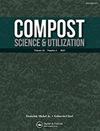水分和密度对橄榄饼堆肥导热系数的影响:实验和数学模型
IF 0.9
4区 农林科学
Q3 ECOLOGY
引用次数: 1
摘要
生物活性化合物在生物过滤器、土壤改善剂堆肥和绿色屋顶建筑中处理气态污染物的行为受其热性质控制。关于橄榄饼堆肥(OCC)的导热系数、K受含水量和堆积密度的影响的信息缺乏。采用单探针法测定了40个(OCC)样品在容重(400 ~ 950 kg/m3)和含水率(10% ~ 90%)条件下的导热系数(K)。结果表明,导热系数随含水率的增加而线性增加,体积密度随充气孔隙率的减小而增加。堆肥导热系数与干容重和饱和度之间存在简单的线性关系。试验值与最近报道的叶片堆肥和屋顶绿化土壤的试验值接近。含水量为90%时,堆肥的导热系数(K)最高,为0.60 W/m。K,表明堆肥在地热蓄热应用中可以作为一种较好的廉价隔热材料,在绿色屋顶建筑中可以作为一种额外的回波友好隔热层,是一种较好的被动节能手段。本文章由计算机程序翻译,如有差异,请以英文原文为准。
Thermal Conductivity of Olive Cake Compost (OCC) as Affected by Moisture and Density: An Experimental and Mathematical Modeling
Abstract The behaviors of bioactive compounds treating gaseous pollutants in biofilters and in the compost used as soil amendment and in green roof buildings are controlled by their thermal properties. There is a lack of information on thermal conductivity of olive cake compost (OCC), K as affected by water content and bulk density. Thermal conductivities (K) of 40 samples of (OCC) were determined experimentally at bulk densities (400–950 kg/m3) and moisture contents (10%–90%) using a single thermal probe method. The results showed that thermal conductivity increased linearly as water content, and bulk density increased and with a decrease in air filled porosity. Simple linear relationships were developed between compost thermal conductivity and dry bulk density and the degree of saturation. The experimental values were close to those reported recently for leaf compost and green roof soils. The compost at water content of 90% showed the highest thermal conductivity (K) of 0.60 W/m.k, which indicate that compost, can be used as good cheep insulator in geothermal heat storage application and as an additional echo-friendly insulation layer in green roof building which might be considered as a good means of passive energy saving there.
求助全文
通过发布文献求助,成功后即可免费获取论文全文。
去求助
来源期刊

Compost Science & Utilization
农林科学-生态学
CiteScore
4.10
自引率
0.00%
发文量
0
审稿时长
>36 weeks
期刊介绍:
4 issues per year
Compost Science & Utilization is currently abstracted/indexed in: CABI Agriculture & Environment Abstracts, CSA Biotechnology and Environmental Engineering Abstracts, EBSCOhost Abstracts, Elsevier Compendex and GEOBASE Abstracts, PubMed, ProQuest Science Abstracts, and Thomson Reuters Biological Abstracts and Science Citation Index
 求助内容:
求助内容: 应助结果提醒方式:
应助结果提醒方式:


